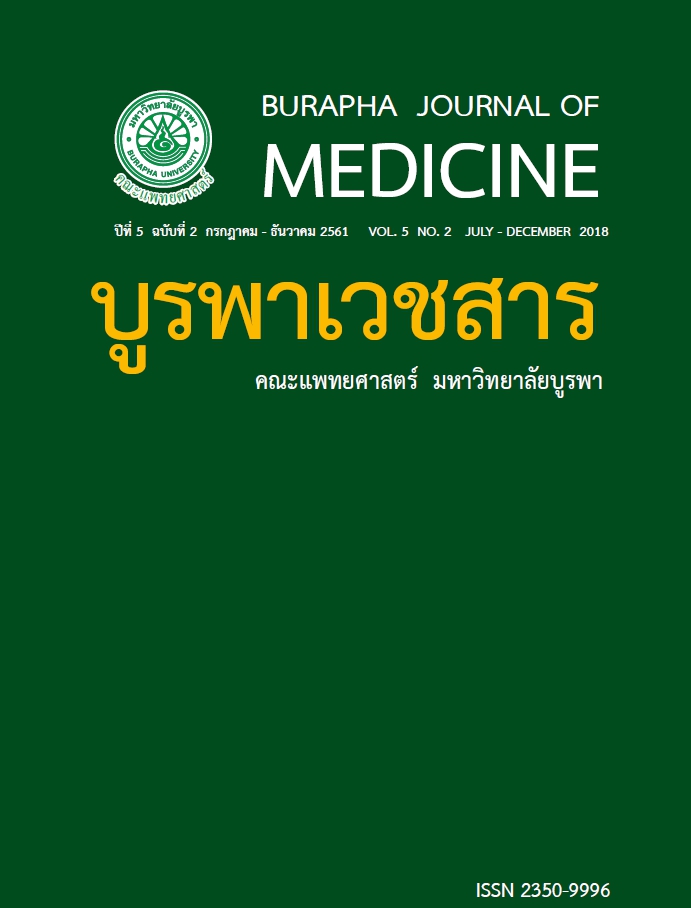แบบสอบถามคัดกรองภาวะมวลกล้ามเนื้อน้อยชนิด SARC-F มีความสัมพันธ์กับสมรรถภาพ ทางกายและความแข็งแรงของกล้ามเนื้อในผู้สูงอายุไทย
คำสำคัญ:
มวลกล้ามเนื้อน้อย, สมรรถภาพทางกาย, ความแข็งแรงกล้ามเนื้อบทคัดย่อ
Objective To evaluate the correlation between SARC-F scores, physical performance, muscle
strength and relative skeletal muscle indices in older Thai adults.
Materials and Methods The current study recruited male and female patients over 60 years
old who were then receiving treatment at Burapha University Hospital. These patients could
walk without any walking aids. The clinical data was collected from January to July, 2017.
Specifically, three factors of the examinations were administrated: X-ray screening by DEXA,
and the measurements of muscle strength as well as physical performance, respectively.
Results One hundred and eighty-seven patients took part in this study, with the overall age
range between 65 and 69 years old, and average weight between 56 and 63 kilograms. Of the
187 patients, 159 of them (85%) were female. According to the AWGS (Asian Working Group
for Sarcopenia) the definition of sarcopenia is < 5.4 kg/m2, with a SARC-F score < 4 points.
Physical performance was assessed with a Timed Up and Go test (TUG), and revealed a 6-m
gait speed at 10.7 S.D. 3.7 seconds for the normal group, but was 21 S.D. 8.1 seconds in the
sarcopenic group. The 6-m gait speed showed 1.5 S.D. 1.4 m/seconds in the normal group, but
3.7 S.D. 2.6 m/seconds in the sarcopenic group. In addition, the muscle strength test (tested
with a grip dynamometer) revealed that the average grip strength score in the normal group
was 10.3 S.D. 4 kg, compared with 7.3 S.D. 4.5 kg in the sarcopenic group.
Conclusions The results revealed a lower physical performance and reduced muscle strength
in sarcopenia patients in comparison to the normal group. This evidence also suggests a higher
risk of fall incidents in patients with sarcopenia.
References
1. Cuesta F, Formiga F, Lopez-Soto A, Masanes
F, Ruiz D, Artaza I, et al. Prevalence of
sarcopenia in patients attending outpatient
geriatric clinics: the ELLI study. Age Ageing.
2015; 44: 807-9.
2. Chen LK, Liu LK, Woo J, Assantachai P,
Auyeung TW, Bahyah KS, et al. Sarcopenia
in Asia: consensus report of the Asian
Working Group for Sarcopenia. J Am Med
Dir Assoc. 2014; 15: 95-101.
3. Woo J, Leung J, Morley JE. Validating the
SARC-F: a suitable community screening
tool for sarcopenia? J Am Med Dir Assoc.
2014; 15: 630-4.
4. Malmstrom TK, Miller DK, Simonsick EM,
Ferrucci L, Morley JE. SARC-F: a symptom
score to predict persons with sarcopenia
at risk for poor functional outcomes. J
Cachexia Sarcopenia Muscle. 2016; 7: 28-36.
5. Rolland Y, Dupuy C, Abellan Van Kan
G, Cesari M, Vellas B, Faruch M, et al.
Sarcopenia screened by the SARC-F
questionnaire and physical performances
of elderly women: A cross-sectional study.
J Am Med Dir Assoc. 2017; 18: 848-52.
6. Tanaka S, Kamiya K, Hamazaki N, Matsuzawa
R, Nozaki K, Maekawa E, et al. Utility of
SARC-F for assessing physical function in
elderly patients with cardiovascular disease.
J Am Med Dir Assoc. 2017; 18: 176-81.


